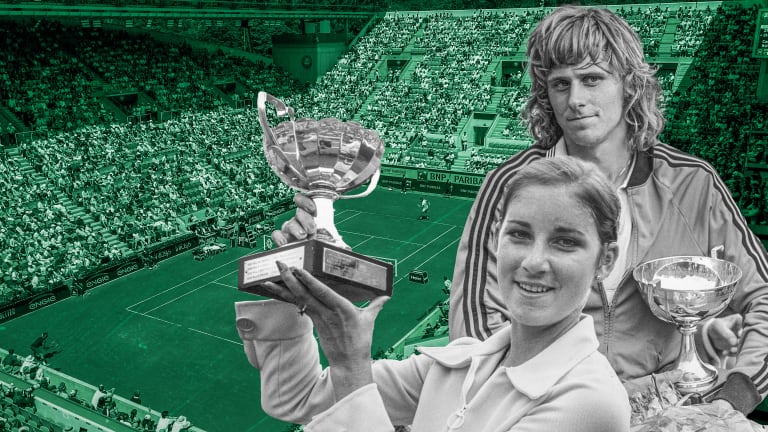
Fifty years ago, two young tennis prodigies, Bjorn Borg and Chris Evert, captured their first Grand Slam titles at the 1974 French Open, forever altering the landscape of professional tennis. Their victories not only marked the beginning of illustrious careers but also laid the groundwork for how the sport is played, marketed, and perceived today. As the tennis community reflects on this milestone anniversary, discussions surrounding their legacies and the evolution of the game have reignited, showcasing how these two champions continue to inspire new generations.
The Historic Weekend at Roland Garros
The 1974 French Open was a landmark event in tennis history. Borg, then just 18 years old, defeated Manuel Orantes in the men’s final, while Evert, at 19, triumphed over her friend and doubles partner Olga Morozova. Their simultaneous victories turned Roland Garros into a stage for what many would later refer to as “the ice storm,” a nod to their calm demeanours and formidable skills on clay.
Evert’s path to victory was characterised by her precision and tactical prowess. She dominated the tournament with a series of straight-set wins, culminating in a decisive final where she showcased her powerful two-handed backhand. “I was determined to come back and redeem myself after my previous losses,” Evert reflected on her journey to that moment. Her victory not only marked her first Grand Slam title but also solidified her status as a force in women’s tennis.
Borg’s journey was more tumultuous; he faced significant challenges throughout the tournament, including coming back from two sets down in the quarterfinals against Raul Ramirez. His resilience paid off as he emerged victorious in a grueling final against Orantes. Borg’s unique playing style—characterized by his two-handed backhand and exceptional stamina—set new standards for future generations of players.
The Impact on Tennis
Borg and Evert were not just champions; they were pioneers who helped shape modern tennis. Their playing styles introduced new techniques that have since become staples of the sport. The two-handed backhand that both players favoured is now ubiquitous among professional players, allowing for greater control and power.
Moreover, their success during the Open Era coincided with a significant cultural shift in sports. As tennis became more commercialised and accessible to broader audiences, Borg and Evert emerged as icons who appealed to fans worldwide. Their charisma and professionalism set new standards for athlete conduct both on and off the court.
The Rise of “Borg-mania” and “Evert-mania”
The phenomenon surrounding both players—often referred to as “Borg-mania” and “Evert-mania”—captivated fans during the 1970s. Borg’s long hair and cool demeanour made him a heartthrob among teenage girls, while Evert’s wholesome image resonated with fans looking for relatable role models in sports. Their popularity helped elevate tennis from a niche sport to a mainstream spectacle.
In many ways, they paved the way for future stars like Serena Williams and Roger Federer, who have similarly combined athletic prowess with marketability. As tennis continues to evolve, the influence of Borg and Evert remains evident in how athletes approach their careers today.
Reflections from Tennis Experts
In recent discussions among veteran tennis journalists about Borg and Evert’s lasting legacies, many emphasized their contributions beyond just titles. Peter Bodo noted that “Borg and Evert set the bar for sportsmanship high at a time when fans were drawn to more controversial figures.” This sentiment reflects how their professionalism helped maintain integrity within the sport during an era marked by flamboyant personalities like Jimmy Connors and John McEnroe.
Jon Levey added that “their incredible powers of concentration remain in the 00001 percent of anyone who’s ever held a racquet.” This level of discipline allowed them to dominate lengthy rallies—a hallmark of their playing styles that continue to inspire aspiring players.
The Ongoing Conversation
As the tennis world commemorates 50 years since Borg and Evert’s maiden major titles, conversations about their impact are more relevant than ever. The sport has undergone significant changes since their time; however, many principles they embodied—dedication, sportsmanship, and innovation—remain essential.
In recent months, discussions have centred around how current players can learn from these legends. With rising stars like Coco Gauff and Carlos Alcaraz capturing headlines, there is an ongoing dialogue about how they can carry forward the legacies of past champions while also carving out their own identities in an increasingly competitive landscape.
The Role of Social Media
Social media has transformed how athletes engage with fans today compared to Borg and Evert’s era. While they relied on traditional media outlets for exposure, modern players can connect directly with audiences through platforms like Instagram and Twitter. This shift has created new opportunities for marketing but also introduces challenges regarding privacy and public perception.
As current players navigate this landscape, they can look to Borg and Evert’s examples of professionalism as guiding principles. Maintaining focus on performance while managing external pressures is crucial for success in today’s sporting environment.
A Legacy That Endures
The achievements of Bjorn Borg and Chris Evert at the 1974 French Open are milestones etched into tennis history. Their simultaneous victories not only marked the beginning of legendary careers but also transformed how tennis is played and perceived globally. As we reflect on this significant anniversary, it is clear that their legacies continue to inspire new generations of athletes.
In celebrating their accomplishments, we must also recognise the ongoing evolution of tennis as it adapts to modern challenges while honouring its rich history. As current stars emerge on the scene—drawing inspiration from icons like Borg and Evert—the future of tennis looks bright.
Ultimately, Borg and Evert’s stories remind us that greatness is not solely defined by titles won but by how athletes carry themselves both on and off the court. Their influence will resonate long into the future as they remain foundational figures in shaping not just tennis but sports as a whole.
Leave a Reply